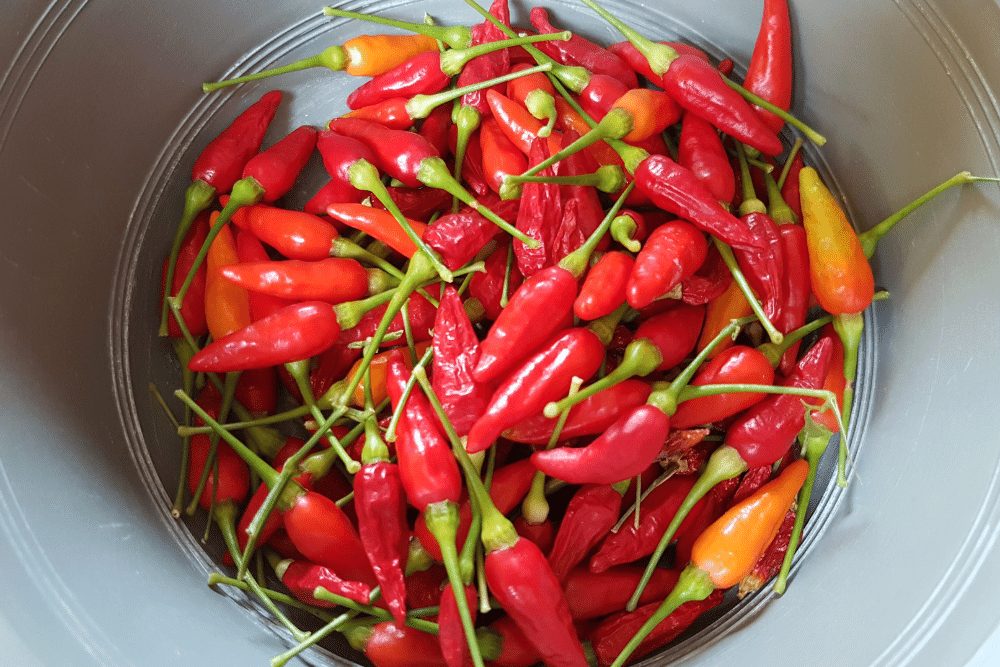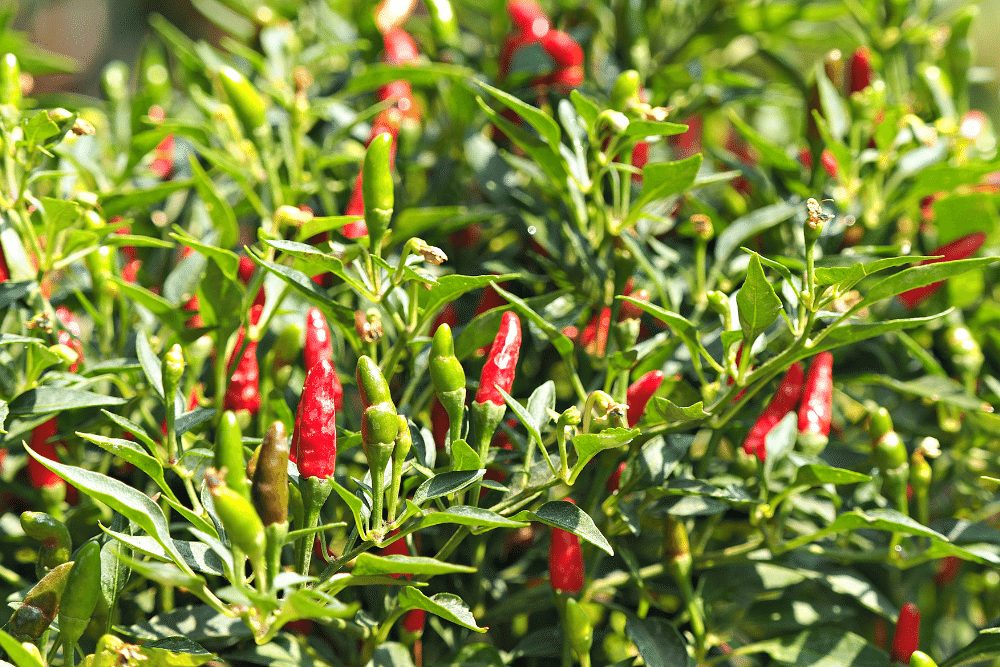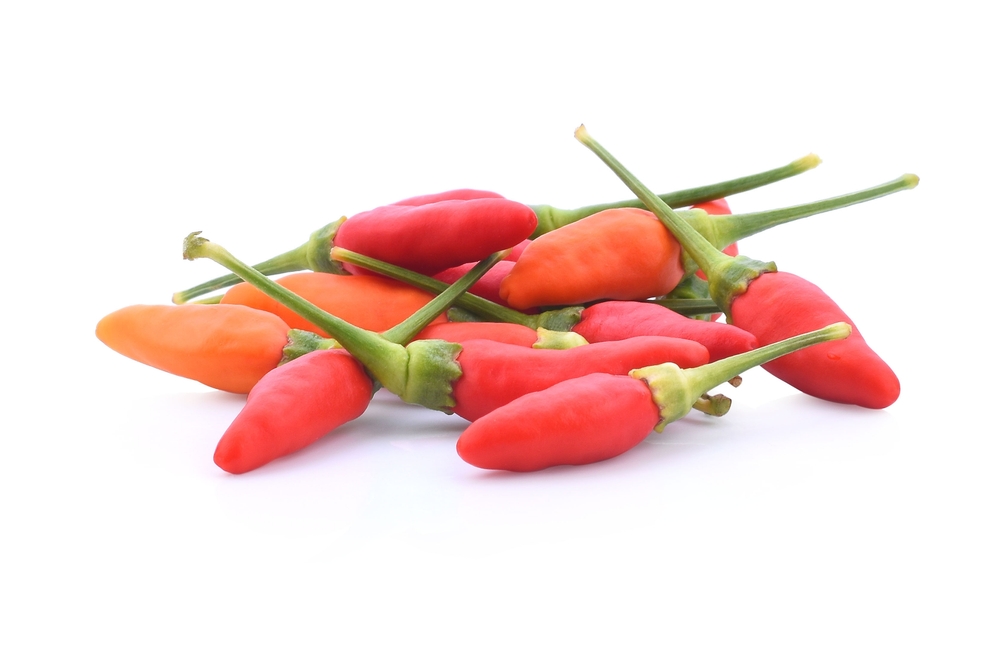Birds eye chile pepper, also known as Thai chilis, is a tiny elongated pepper originating from Thailand and the neighboring countries. They’re primarily used in Southeast Asian cuisine, though they’re now common worldwide. These tiny chilis prefer hot climates and grow on small bushes in the wild, and are easily cultivated in the home garden.
What Is A Birds Eye Chili?
Birds eye chili peppers are thin, small, and pointed peppers that turn red when ripe. Some varieties ripen to a purple or orange, and any can be harvested and eaten when green for a less spicy and fresher flavor.
It is believed to have originated from Africa, Vietnam, The Philippines, Thailand, Cambodia, and the surrounding countries where it grows wild in African countries like Ethiopia.
Those known as Thai chiles originate from Southeast Asia, where the climate is hot. Birds eye peppers are bushy plants with narrow fruits with pods averaging five centimeters long with a diameter of around one centimeter. They’re known as Birds eye chili peppers because of their small pointed shape, and because they are spread by birds unaffected by the peppers’ heat.
They sometimes resemble the Serrano pepper, but the latter is rounder and fatter, while Birds eye chili is thinner.

Historically, they have been used as a natural remedy for flatulence, toothache, rheumatism, and arthritis and could have been used as insect repellents when mixed with water. They are also effective in treating inflammation due to the presence of capsaicin.
Other Names For Birds Eye Chilis
A variety from the capsicum annuum species, Birds eye chilis have various names depending on the location. Some of these include:
- Birds eye chili
- Piri Piri or Peri-peris
- Rat/mouse-dropping chili
- Southeast Asia birds eye chili
- Thai bird chiles
- Thai chiles
- Thai chili
How Hot Are Birds Eye Chilis?
Birds eye chiles are famous for their peppery, fruity flavor and intense heat. Despite their size, they pack a serious punch, ranging from 50,000 to 100,000 Scoville heat units on the Scoville scale.
This is ten times hotter than a jalapeno, but about half the heat of a habanero.

Mature red Birds eye chilis can be very pungent and very hot, while others have a slow burn with the heat building up as you enjoy your meal and then lingering long after.
Birds Eye Chilis In Cooking
Birds eye chili is common in Southeast Asian cuisine, such as Thai, Vietnamese, Malaysian, Singaporean, Indonesian, Khmer, and Lao. Popular dishes include curries, salads, soups, and fermented hot sauces.
You can find Birds eye chilis at your local grocery store or an Asian market. Some of the best flavors to go with the pepper include ginger, garlic, soy sauce, fish sauce, and cilantro.
Common dishes that use the Thai chili pepper include khao soi, spicy Thai curry chicken soup, Thai chicken wings with chili-peanut sauce, and of course, various stir fry dishes.
It is also used as a condiment due to its bright and appealing colors. You’ll find it in the popular sambal oelek chili paste and red curry paste, and more.
Note: Always be careful when cooking with the Birds eye, as the capsacin oil can cause pepper burns. Remember that the pepper oil will stay on your skin for hours or days, even after thoroughly washing your hands.
Remove the seeds and ribs before cooking with the chili if you want to lessen the heat. Usually, the highest capsaicin concentration is found in the seeds.
You can easily find pre-made seasonings and other products derived from birds eye chilis, such as marinades, salsas, and dry seasoning blends. They’re often included in spicy fermented hot sauce, and they can be smoked, dried and ground into a hot chili powder.
Where To Buy Birds Eye Chilis
Birds eye chiles are very common worldwide, and you can often purchase them at your local grocery store or supermarket all year round.
They are sold either individually or in small packages and range in color from green to red. You can also find dried Birds eye chilis on Amazon or Asian online retailers.
When purchasing at the store, select firm, bright peppers without wrinkles or blemishes. Green ones are milder, while brightly colored ones, either purple, red, or orange, are hotter.
Substitutes For Birds Eye Chilis
If you can’t find Birds eye chilis in your local store, there are several substitutes with similar heat and flavor.
- Cayenne pepper
- Habanero pepper
- Jalapeno pepper
- Scotch bonnet (Bonney pepper)
- Serrano pepper
Can You Grow Birds Eye Chilis?
It’s easy to grow your own Birds eye chilis, and you won’t have to wait long for them to ripen. Most varieties take 3-4 months from planting to harvesting, and like most peppers, they do well in hot, humid climates.
Birds eye chili peppers like loose, loamy, well-drained soil, and overwatering can cause rot. Choose a sunny spot in your garden or a south-facing window inside that gets at least six hours of sun per day.

Are Bird Eye Chillies Good For You?
Yes! The compound capsaicin, which is what gives chili peppers their heat,

